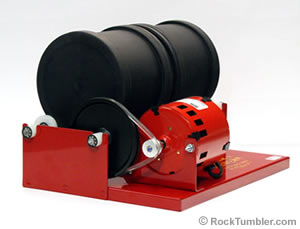
An example of a rotary rock tumbler. This Thumler's A-R2 tumbler has two three-pound barrels. Rotary tumblers take about four to eight weeks to process a load of rock - one week for each of the following steps: coarse grind, medium grind, fine grind and polish. Some people run their rocks for two or more weeks in the coarse grind to obtain tumbled stones with more rounded shapes and smoother finishes.
Categories of Rock Tumblers
Rock tumblers are made in many sizes and qualities. Some will tumble just a few ounces of rock, while others can process thousands of pounds of rocks in a single load.
Rock tumblers are made in a wide quality range. Some are designed with the objective of being sold for a very low price. These tumblers might last through a few batches of rocks, but are not designed for long-term use. Some are high-quality machines that can last through decades of regular use, if carefully cared for and gently operated (just as you should treat your automobile), needing only regular cleaning, regular lubrication, and an occasional replacement part.
We believe that most tumblers belong in one of the four groups listed below: toy tumblers, beginner's tumblers, hobbyist tumblers and commercial tumblers.
The information below is personal opinion, developed after being a rock tumbling hobbyist for over 40 years, owning and using dozens of tumblers, selling thousands of tumblers, and communicating with thousands of consumers.
Each of these tumbler categories has a legitimate place in the market. They target consumers at different spending levels and consumers with different performance expectations.
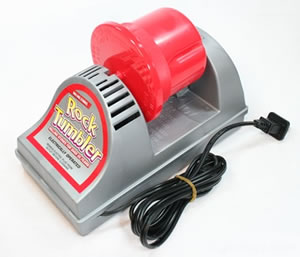
An example of a toy rock tumbler. This one has been sold as the "Smithsonian Rock Tumbler" and as the "Rolling Stones Rock Tumbler" by NSI International, Inc.
Toy Rock Tumblers
Toy tumblers are easy to identify. They have a plastic base and a small plastic barrel that will tumble between 1/4 and 1 pound of rocks. When a toy tumbler is running, the rocks impacting the inside of the plastic barrel will produce a large amount of noise.
We believe that toy tumblers have done more to build the reputation that "rock tumblers are noisy" than any other type of tumbler. Much larger beginner's and hobbyist tumblers operate with a small fraction of the noise.
Manufacturers design toy tumblers with the goal of producing a child's toy that will sell at a low price. The best way to cut costs when building a tumbler is to use a low-cost motor. A low-cost motor and a low-cost plastic barrel are what you get in many toy tumblers. The motor, the barrel, or a drive train component often fails before a few batches of rocks have been polished.
Should you buy a toy tumbler? I purchased and operated several toy tumblers, so I can give an opinion based upon experience. I believe that most toy tumblers make a lot of noise for an entire month to produce a half-cup of stones that do not have a nice polish. Combine that with their failure rate, and these tumblers are giving rock tumbling a bad reputation. If a person spends a little more money, they can get a much better rock tumbler.
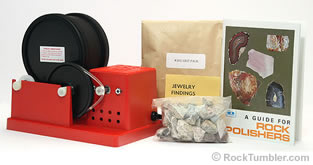
An example of a beginner's rock tumbler. This one has a plastic base and a small rubber barrel that will process about one pound of rocks. It is the Thumler's Model MP-1 rock tumbler. It is sold with a guide book, enough supplies to process your first batch of rocks, and a small jewelry kit that will enable you to make a key chain and a necklace from the rocks that you tumble. Replacement parts can be purchased, should you ever need one. The fact that replacement parts are sold is a good sign. If you can't readily find replacement parts for a tumbler, we think that means you might have purchased a throw-away product. We test tumbling rough in one of these tumblers. We started using it when these tumblers were first produced in 2009. It has tumbled many batches of rocks, and the original motor, barrel, and belt are still in service.
Beginner's Rock Tumblers
The identifying features of most beginner's rock tumblers are a plastic base and a small rubber barrel. The barrel is usually large enough to tumble one or two pounds of rocks. They operate with less noise, produce a larger amount of rocks, and produce rocks with a better polish than most of the toy rock tumblers that we have seen.
Their plastic base is not necessarily a bad feature. We purchased several beginner's tumblers and tumbled several batches of rocks with each of them. Some of these tumblers are well-made, quiet, operate smoothly, produce a nice polish, and last through many batches of rocks.
Replacement parts for beginner's tumblers are often hard to find or not available. So we can't say that all beginner's tumblers will last through many years of use or be used by multiple generations of a buyer's family.
Marketers often call these tumblers "powerful", "high-capacity", or "heavy-duty". We do not think these adjectives apply to beginner's tumblers. They belong to machines in the "hobbyist" or "commercial" category.
We were happy with most of the beginner's tumblers that we tested but are unable to recommend many of them for one reason. They are too fast! They are not just a little bit too fast - the barrel spins so quickly that these machines do not have the ability to produce nice tumbled stones for many types of rock.
What types of rocks can the "too fast" beginner's tumblers successfully polish? In our opinion, they can do a good job tumbling rocks that meet these specifications:
- small size (3/8 to 1 inch in size)
- Mohs hardness of about 7
- rocks that do not break, cleave or bruise easily
- chalcedony, jasper, and agate are perfect rocks for these tumblers
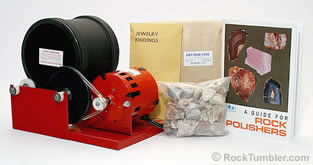
The Thumler's A-R1 rotary tumbler is an example of a hobbyist tumbler. Compared to the Thumler's MP-1 above, the A-R1 has a larger barrel, a metal base, and a much higher quality motor. Many people use them for many years, and they are later used by their children as well.
Hobbyist Rock Tumblers
Hobbyist tumblers are designed and built to last through years of regular or occasional use. They have high-quality metal bases, quality rubber barrels (of at least 3-pound capacity), and quality motors. A hobbyist tumbler will cost more than a beginner's tumbler, but you get what you pay for.
It is not unusual for hobbyist tumblers to be used by a person in their youth, and then that same person will use the same tumbler with their children or grandchildren. That is the life expectancy of many hobbyist tumblers if they are maintained properly and used gently.
If you need a replacement part for a hobbyist tumbler, they are usually easy to obtain from the manufacturer or by doing an internet search. The cost of a set of bearings can save you the cost of buying a new tumbler.
In our opinion, most vibratory tumblers are built to hobbyist quality levels. They are more expensive to purchase than rotary tumblers. The people who buy them are generally more experienced and are willing to pay the cost of a higher quality machine.
With regular lubrication and common-sense use, many hobbyist tumblers last for decades and across generations of a family. Small hobbyist tumblers usually have three-pound barrels, which is a more worthy amount than what you get with a beginner's tumbler. Larger hobbyist tumblers have six-, twelve-, or fifteen-pound capacity barrels.
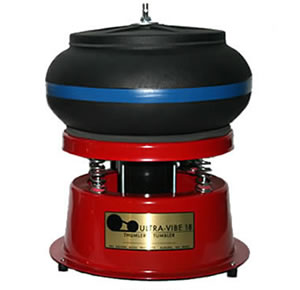
The Thumler's UV-18 vibratory tumbler is purchased by businesses or individuals who are heavy users of vibratory tumblers. It is built to last for years. Thumler's U-V18 vibratory tumbler.
Commercial Rock Tumblers
Commercial tumblers are large tumblers that a company or an individual can use to produce tumbled stones, polish pre-formed cabochons, clean rough stones before sorting, polish ammunition casings, or perform other tasks as part of a very serious hobby or business. The words "high-capacity", "heavy-duty", etc. belong here.
Commercial tumblers are expensive. A small (ten to twenty pound) commercial tumbler will cost a minimum of a few hundred dollars, and a larger commercial tumbler can cost over one thousand dollars. However, the electricity and labor cost for the amount of stones processed is much lower than using small tumblers. People who do tumbling in this quantity are usually collecting their own rough, purchasing rough by the barrel, and obtaining their supplies in large quantities.
The weight of the stones in the large barrel produces a more aggressive tumbling action, resulting in a faster stone processing rate. A strong person is needed to handle the barrels, and a good system for handling the used slurry is needed if you are running these machines.
Happy Tumbling!
RockTumbler.com Authors
 |
Hobart M. King has decades of rock tumbling experience and writes most of the articles on RockTumbler.com. He has a PhD in geology and is a GIA graduate gemologist. He also writes the articles about rocks, minerals and gems on Geology.com. |

